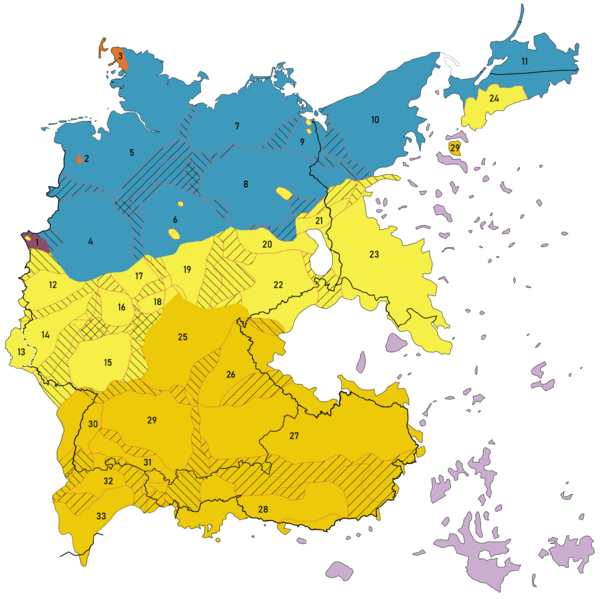Archivo: German dialect continuum in 1900 (according to Wiesinger, Heeroma & König)

Descripción: A map describing the principal dialect groupings of the German dialect continuum around the year 1900. Based on: W. Heeringa: Measuring Dialect Pronunciation Differences using Levenshtein Distance, University of Groningen, 2009, pp. 232-234. P. Wiesinger: Die Einteilung der deutschen Dialekte. In: Dialektologie. Ein Handbuch zur deutschen und allgemeinen Dialektforschung, series: HSK 1.2, Berlin, New York, pp. 807-900 W. König: dtv-Altas Deutsche Sprache, 2019, Munich, pp. 230. J. Goossens: Deutsche Dialektologie, Walter de Gruyter, 1977, pp. 48. C. Giesbers: Dialecten op de grens van twee talen, Radboud Universiteit Nijmegen, 2008, pp. 233. Note: The majority of the map is based on that of Wiesinger, the former eastern areas of the German language are principally based on König. When in conflict in one another, priority was given to Wiesinger. Legend: Lines The thin white/black dashed line represents the area in which two Dachsprachen are present: Luxemburgish (alongside Standard German) in Luxemburg. Striped lines indicate transitional dialects. Low Franconian / Netherlandic varieties: (purple) 1. Lower Rhenish Frisian varieties: (orange) 2. Saterlandic (last remnant of East Frisian) 3. North Frisian Low Saxon / Low German varieties: (blue) 4. Westphalian 5. Northern Low German 6. Eastphalian (one yellow part inside is Erzgebirgisch in part of the Harz) 7. Mecklenburg-Pomeranian 8. Brandenburgish (the yellow part inside is Berlinian in Berlin) 9. Middle Pomeranian 10. Eastern Pomeranian 11. Low Prussian Middle German / Central German varieties: (yellow) 12. Ripuarian 13. Luxemburgish (closely related to Moselle Franconian, but different written standard) 14. Moselle Franconian 15. Rhine Franconian 16. Central Hessian 17. Northern Hessian 18. Eastern Hessian 19. Thuringian 20. Northern Upper Saxon 21. South Märkisch 22. Upper Saxon 23. Silesian 24. High Prussian Note 1: The empty part near 25, 26, 27 isn't a lake but Sorbian, a Slavic variety. Note 2: Transylvanian Saxon spoken in Transylvania (Romania) is missing on this map. Upper German varieties: (ochre) 25. Upper Franconian: East Franconian and South Franconian (South Rhine Franconian) 26. North Bavarian 27. Central Bavarian 28. South Bavarian 29. Swabian 30. Low Alemannic 31. Middle Alemannic 32. High Alemannic 33. Highest Alemannic
Título: German dialect continuum in 1900 (according to Wiesinger, Heeroma & König)
Créditos: Trabajo propio
Autor(a): Vlaemink
Términos del Uso: Creative Commons Attribution-Share Alike 4.0
Licencia: CC BY-SA 4.0
Enlace de Licencia: https://creativecommons.org/licenses/by-sa/4.0
¿Se exige la atribución?: Sí
Usos del archivo
La siguiente página enlaza a este archivo:

